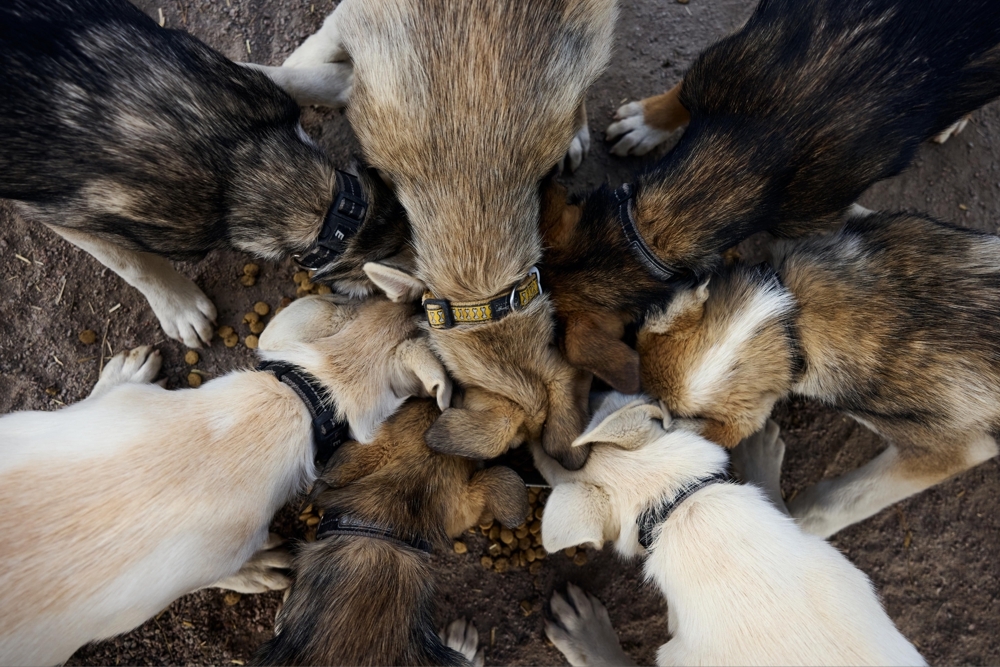Appetite First: Building Eager Eaters in Our Puppies
At Bearhill, feeding our puppies is never just about filling bowls. It’s about building confident, reliable eaters — dogs that are excited for every meal and ready to refuel whenever and wherever it’s offered.
Appetite Is the Goal
In sled dogs, appetite is one of the most important traits. A dog that eats well recovers faster, trains better, and works harder. Developing that strong food motivation starts in puppyhood, and it requires a thoughtful, flexible approach.
Many Methods, One Intention
There’s no single ‘right’ way to feed puppies. What matters is understanding the goal: building a positive, enthusiastic relationship with food. Depending on the litter, we might use different strategies — and often switch between them based on how each puppy responds.

The Light but Frequent Approach
One method is feeding slightly less than what would leave every puppy totally full — say, food for eight pups instead of nine. This creates a natural enthusiasm around meals, encourages focus during feeding, and helps prevent pickiness from ever developing. When pups learn that food appears briefly and then disappears, they start showing up ready to eat. This approach works best when feeding multiple small meals a day.
The Full and Satisfied Approach
On the flip side, some puppies benefit from one generous meal per day — enough that every pup eats their fill and walks away satisfied. This builds a habit of eating a full portion in one sitting, which is a vital trait for working dogs who may not always have multiple meals during expedition days. As long as the pups are growing well and eating with enthusiasm, this method can be just as effective.
Creating Positive Eating Habits
Whatever feeding style we use, the goal is to create strong, enthusiastic eaters. Puppies should associate food with focus and satisfaction. If a pup like Twinkie isn’t finishing meals, we adjust. Sometimes this means slightly reducing the portion so they’re more eager next time. Other times it means spacing meals further apart or offering more food during or after a walk when appetite is naturally stronger.
We watch closely, adjust quickly, and always aim to match the method to the pup — not the other way around.
Feeding as a Training Tool
We use snacks on walks to build positive reinforcement, strengthen attention, and boost motivation. A puppy who knows food is part of the training experience is more likely to stay focused, return when called, and build a reliable work ethic. These small interactions during exercise directly support their appetite later in the day — both mentally and physically.

Clean Bowls, Clear Communication
Whatever approach we take, we make sure to keep things clean and simple: no leftover food sitting in bowls, no guessing how much they ate. If food is left, we take it away and adjust the next meal accordingly. This keeps routines healthy, especially as the weather warms up.
We also make sure to communicate clearly within the team. If one handler feeds a reduced portion or sees a change in a pup’s appetite, they pass that on to the next shift. That consistency is key to developing reliable eaters.
Appetite Over Routine
At the heart of it all is the understanding that feeding isn’t just routine — it’s a cornerstone of our training philosophy. We want dogs that are excited to eat, willing to work, and resilient in the face of change. Building appetite is a process, and we shape it every day, one bowl at a time.
If you would like to learn more about our procedures, policies, and training methods, check out the blog articles below.
- Why We Walk the Puppies: Building the Foundation for a Sled Dog’s Life
- Why the Dog Walker is One of the Best Tools in Our Kennel
- The Painted Puppies: Why We Mark Our Pups with Nail Polish
- Why We’re a No-Kill Kennel: Bearhill’s Approach to Euthanasia and End-of-Life Care
- Polarised Sled Dog Training: Building Strength and Endurance at Bearhill
- Preparing for Winter: Training Dogs, Training People, and Building a Stronger Team
- Sled Dog Endurance Training: Gradual Progress and Recovery for Peak Winter Fitness



